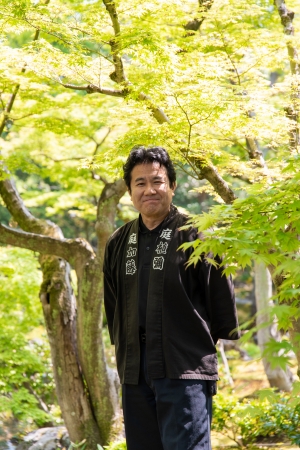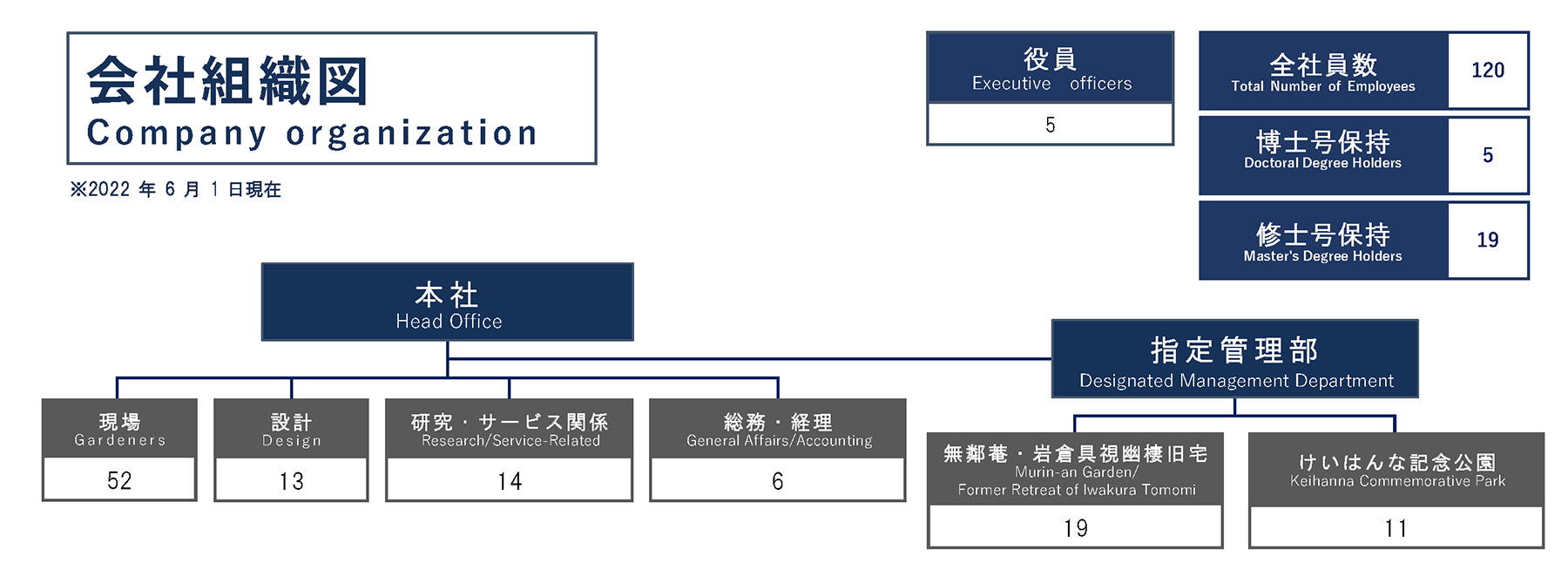About

-fostering gardens-
Ueyakato Landscape uses traditional Japanese garden fostering techniques to nurture new scenery that will last for generations to come.
Scenery is created by the natural environment, human activity, and the society that surrounds both of them.
By incorporating into today’s society the techniques that have been used to tend to gardens for centuries, we can also nurture an enriched scenery for the future.
In addition to garden creation and management, we are devoted to utilizing gardens in accordance with their surrounding social environment.
To the greatest degree possible, we draw out the appeal that Japanese gardens have as points of convergence where varied forms of Japanese culture come together.
Our aim is to contribute to the creation of a better society by continuously nurturing these gardens and communicating their value to the world.
Kyoto’s gardeners have long engaged with nature, thoroughly observing its changes and characteristics down to the finest detail, and reflecting them in their expression of space. In this unprecedented age where people, money and information circulate at unimaginably fast speeds, Ueyakato Landscape strives to discover genuine value that can lead people and society toward a brighter future.
Overview
- Company Name
- Ueyakato Landscape Co., Ltd.
- Address
- Kyoto Head Office:45 Nishiteranomae-cho, Shishigatani, Sakyo-ku, Kyoto-shi, Kyoto-fu 606-8425 JAPAN
Tokyo Office:27-2 Riko Tosho Building, 3rd fl., Ichiban-cho, Chiyoda-ku, Tokyo-to 102-0082 JAPAN - TEL
- Kyoto Head Office:+81-75-771-3052
Tokyo Office:+81-3-3262-8300 - FAX
- 075-752-0154
- kyoto-office@ueyakato.co.jp [Inquiries]
- Established
- 1848
- Capital
- \42.6 million
- Number of employees
- 120
- Board of Directors
- Chairman Daiki Kato
President Tomoki Kato
Director Yoshiki Kato
Executive Yoshiyuki Tajiri
Executive Hajime Anno - Business
- Landscape gardening services (Surveillance, planning, design, construction, maintenance and management of gardens, parks, greens, and forests)
Message from the President

In today’s ultra-convenient society, Japanese gardens, which sometimes are fostered over a period of several centuries, must seem quite inefficient. We believe, however, that it is precisely in our present age that garden fostering techniques may hold the value we need to help shape a better society.
When raising a Japanese garden, actual garden creation consists of 40%, whereas garden fostering is 60%. Garden creation requires a large amount of human and financial capital, which makes a garden’ s construction all the more joyous an occasion. What is important, however, is the fostering of the garden that comes later. This means not just pruning branches, but ceaselessly realizing the garden’s potential as an expression of space. It means sensitively grasping the property owner’s ideas and the garden’s distinctive character as well as accepting and understanding the natural landscape. To do so, we must not only tend the garden directly, but communicate its appeal in easy-to-understand terms and thereby nurture a spirit of cherishing gardens. It is through this nurturing act that Japanese gardens provide us with enrichment and peace of mind that all people can share in.
About 1,200 years ago, the “Sakuteiki” (Records of Garden Making) taught us that man-made gardens never exceed the beauty of nature. This means human technique is never superior to nature’s design, and we must thus honor nature and learn from it. As we approach our daily work of nurturing gardens in Kyoto, Japan and throughout the world, we keep in our hearts this message from our forebears.
Ueyakato Landscape Co., Ltd. President Tomoki Kato
Professor at Kyoto University of the Arts, Graduate School (PhD). Born 1966. Entered his family's landscaping business after graduating from Chiba University’s Faculty of Horticulture.
Tomoki Kato continues to train himself daily in pursuit of an organization of tasteful and professional landscape craftsmen who carry on Japanese garden culture while also creating tradition through their superior skills, sensitivity, and aesthetic taste.
At Kyoto University of the Arts, he is currently engaged in garden research that is grounded in practical learning. He gives frequent lectures both in Japan and abroad, including the 2014 and 2018 keynote speeches at the international conference of the North American Japanese Garden Association (NAJGA).--> Professor of Japanese Garden Studies at Kyoto University of the Arts (PhD). Born 1966, in Kyoto. Entered his family’s landscaping business after graduating from Chiba University’s Faculty of Horticulture.
Tomoki Kato continues to train himself daily in pursuit of an organization of professional landscape craftsmen who carry on Japanese garden culture while also creating tradition through their superior skills and aesthetic sensitivity.
At Kyoto University of the Arts, he currently advises garden research that is grounded in practical learning. He gives frequent lectures both in Japan and abroad, including the 2014 and 2018 keynote speeches at the international conference of the North American Japanese Garden Association (NAJGA).
Main awards
Japanese Institute of Landscape Architecture Award (Research Thesis Category) | May 2013
2018 ICOMOS Japan Award | December 2018
Japanese Institute of Landscape Architecture Award (Technical Skill Category) | May 2019
Japanese Institute of Landscape Architecture Award (Business Management Category) | May 2021
Main affiliations
Japan Institute of Landscape Architecture (Board Member), Academic Society of Japanese Gardens (Board Member), Japanese Society for Cultural Heritage, Japan Society for the History of Industrial Technology, Japan Association for the Principle of Employee First Management
Our Business Philosophy
Through our gardening business we aim to keep our employees happy both physically and spiritually, and also contribute to the progress and development of human society.
Vision
Permanence and Fashionability
As a sustainably developing company, we contribute to society by passing down "permanence," the essential things that never change, while also incorporating "fashionability," the things changing constantly in response to the needs of each age.
Permanence: Passing Down and Innovating Japanese Garden Culture
The spirit, skill, and stamina necessary to carry on the Japanese garden, a traditional culture admired by the world. The discernment and technique of Kyoto gardeners.
Fashionability: Our Landscape Service Business
In addition to our usual business of creating and fostering gardens, we also create premium guest reception spaces for owners and their associates that draw out the garden's allure to the greatest possible degree.
Overview of Activities

Company Organizational Chart

Awards
- 2023
- Sogetsukai Foundation Best Work Award
Hana Asobi 2022 Kayu Araki - 2022
- Japanese Garden Society 30th Anniversary U30 Article Award Special Recognition Award
Sanae Handa [ Look into the Light of Life and Nurture It: Japanese Gardens and Child-rearing ] - 2021
- Contemporary Master Craftsmen of Kyoto Prefecture (Award Program for Excellent Technicians in Kyoto Prefecture)
Contemporary Master Craftsman of Kyoto Prefecture Yoshiki Kato - 2021
- Japanese Institute of Landscape Architecture, Kansai Branch Award
Yosuke Ota [ Changes in the Higashiyama Landscape Forest on Mt. Kiyomizu and an Outline of its Future ] - 2020
- Good Design Award
"Gather in the garden, nurture the garden": Kyoto-style value creation for cultural properties - 2020
- Japanese Institute of Landscape Architecture, Kansai Branch Award
Daisuke Yoshikawa [ Plant Management and Landscape Layout in Restoration Work for Special Historic Site and Special Place of Scenic Beauty, the Imperial Villa Garden Site of the Ancient Nara Capital ] - 2019
- Japanese Institute of Landscape Architecture Encouragement Award
Tomio Sakaue [ Garden Fostering of the Lawn that Investigates Fundamental Sensitivity of Wildflower Utilization at Murin-an Garden a National Place of Scenic Beauty] - 2019
- Japanese Institute of Landscape Architecture Award (Technical Skill Category)
Mitsuru Yamaguchi, Shinya Watanabe, Tomoki Kato [A "New Ararekoboshi" Pavement Created through the Use of Traditional Techniques in the Unit Construction Method for Paving Stones] - 2018
- ICOMOS Japan Award
Tomoki Kato [Contemporary Policies and Practices in the Conduct and Utilization of Research for the Preservation of Japanese Gardens as Cultural Heritage Sites] - 2018
- Ichizokai Grand Prize, Excellence Award
Mitsuru Yamaguchi, Shinya Watanabe, Tomoki Kato [The Unit Construction Method of Paving Used at Hoshinoya Tokyo] - 2017
- Nagoya City Machinami Design Award
[Renkyo-ji Temple on Takabari Hill] - 2016
- 37th Ishikawa Architecture Prize
[Hoshino Resorts KAI Kaga] - 2016
- Toda Corporation, President's Award
[Hoshinoya Tokyo] - 2016
- Japanese Institute of Landscape Architecture, Kansai Branch Award
Sanae Handa [ Garden Management for “Murin-an: Place of Scenic Beauty” Focusing on its Essential Value: Lawn Management that Utilizes the Wildflowers Cherished by Yamagata Aritomo ] - 2014
- Ichizokai Grand Prize, Excellence Award
Yasutomo Inoue, Yumi Koyama [Hoshinoya Kyoto: Premium Guest Reception from Kyoto Gardeners] - 2013
- Ichizokai Grand Prize, Special Award
Tomio Sakaue [ Maintenance Management of Murin-an -Grasping the sensitivity of the age- ] - 2013
- Japanese Institute of Landscape Architecture, Kansai Branch Award
Tomio Sakaue, Tomoki Kato [ Maintenance Management of Murin-an -Grasping the sensitivity of the age- ] - 2012
- Japanese Institute of Landscape Architecture Award (Research Thesis Category)
Tomoki Kato [ A Study on the Spatial Features of Shosei-en-Consideration of Historical Characteristics Appeared in Utilization Patterns and Scenery Transition ]
